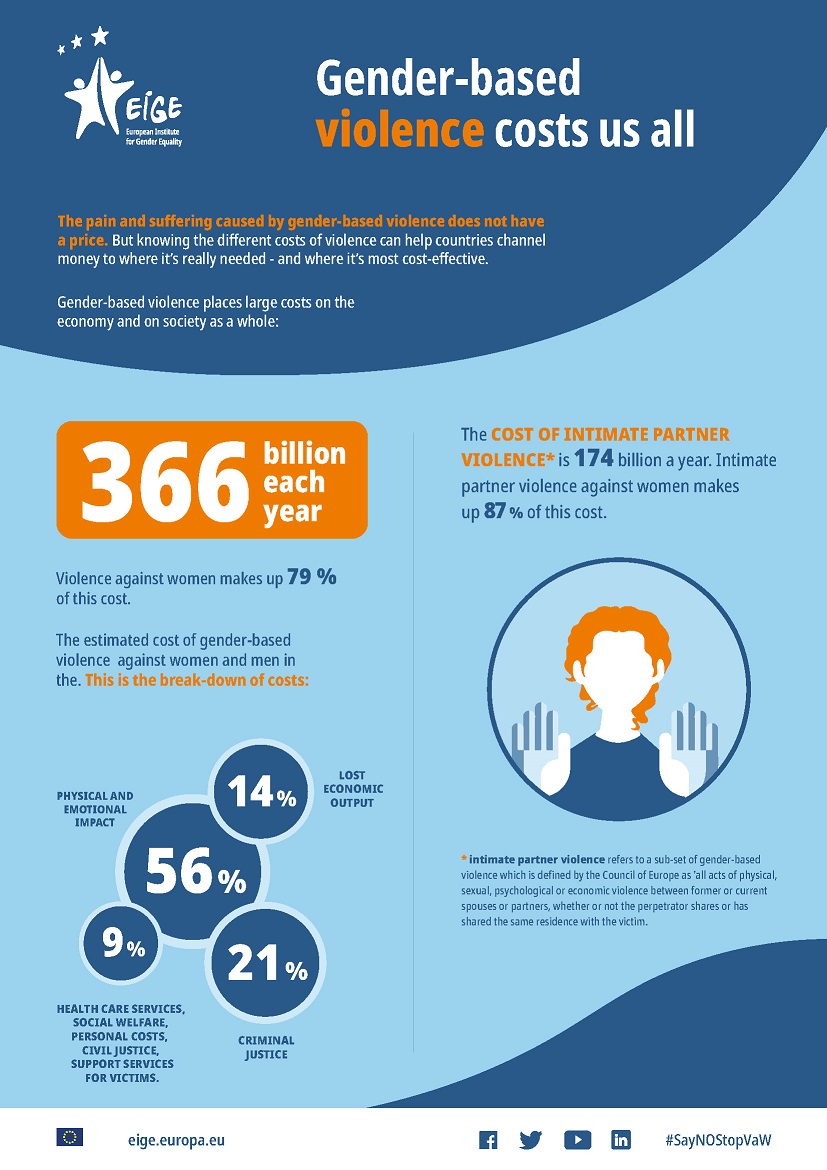Gender-based violence is one of the most severe forms of gender inequality. This issue affects women disproportionally as it is directly connected to the unequal distribution of power between women and men.
The elimination of gender-based violence and the protection of victims is a goal of the European Union and one of the most important areas of work for the European Institute for Gender Equality (EIGE). Identifying the economic costs of gender-based violence contributes to better informed decision-making and supports policy development.
EIGE’s work
EIGE has carried out two studies on the costs of gender-based violence in the European Union. The most recent study provides updated and enriched estimates of the costs of gender-based and intimate partner violence in the EU. The previous study from 2014 analysed the methodological options to measure gender-based violence.
Publications
2021: The costs of gender-based violence in the European Union
This study estimates the costs of gender-based violence using existing methodology from the 2014 study. The report focuses on intimate partner violence as a subset of gender-based violence and provides an updated estimate of the costs of gender-based and intimate partner violence in the EU.
The study is accompanied by the technical report, which provides details on the method and data used for the cost estimation for the UK case study, as well as the extrapolation of the results to the EU Member States.
Read the report "The costs of gender-based violence in the European Union"
Read the accompanying technical report
Main findings
- EIGE has estimated that the cost of gender-based violence across the EU is €366 billion a year. Violence against women makes up 79 % of this cost, amounting to €289 billion. Intimate partner violence makes up almost half (48 %, €174 billion) of the cost of gender based violence. Intimate partner violence against women makes up 87 % of this sum (€151 billion)
- EIGE’s case study analysed three main types of costs:
- Lost economic output relating to a variety of costs associated with the work status and productivity of victims.
- Costs of public services covering health services, personal costs, criminal and civil justice systems, self-funded legal costs, housing aid costs, housing aid and child protection as well as specialist services.
- Physical and emotional impact on the victims accounting for reduction in the quality of life of a victim as a consequence of violence.
- EIGE’s new study indicates that the biggest cost comes from physical and emotional impact (56 %), followed by criminal justice services (21 %) and lost economic output (14 %). Other costs can include civil justice services (for divorces and child custody proceedings for example), housing aid and child protection.
- Costing studies create a better understanding of the extent and associated costs of gender-based violence and support better resource allocation across different policy areas. However, in order to monitor the costs closely, better survey data on the prevalence of gender-based violence and administrative data on the costs and use of services are urgently needed.
In pictures (click to enlarge)
2014: Estimating the costs of gender-based violence in the European Union
The purpose of the study was to identify and recommend appropriate methodologies to measure the cost of gender-based and intimate partner violence in the EU. Following an analysis of existing methodologies for costing studies of gender-based violence, the study recommends a new methodology, illustrated in a case study centred on the UK.
Read the report "Estimating the costs of gender-based violence in the European Union"

